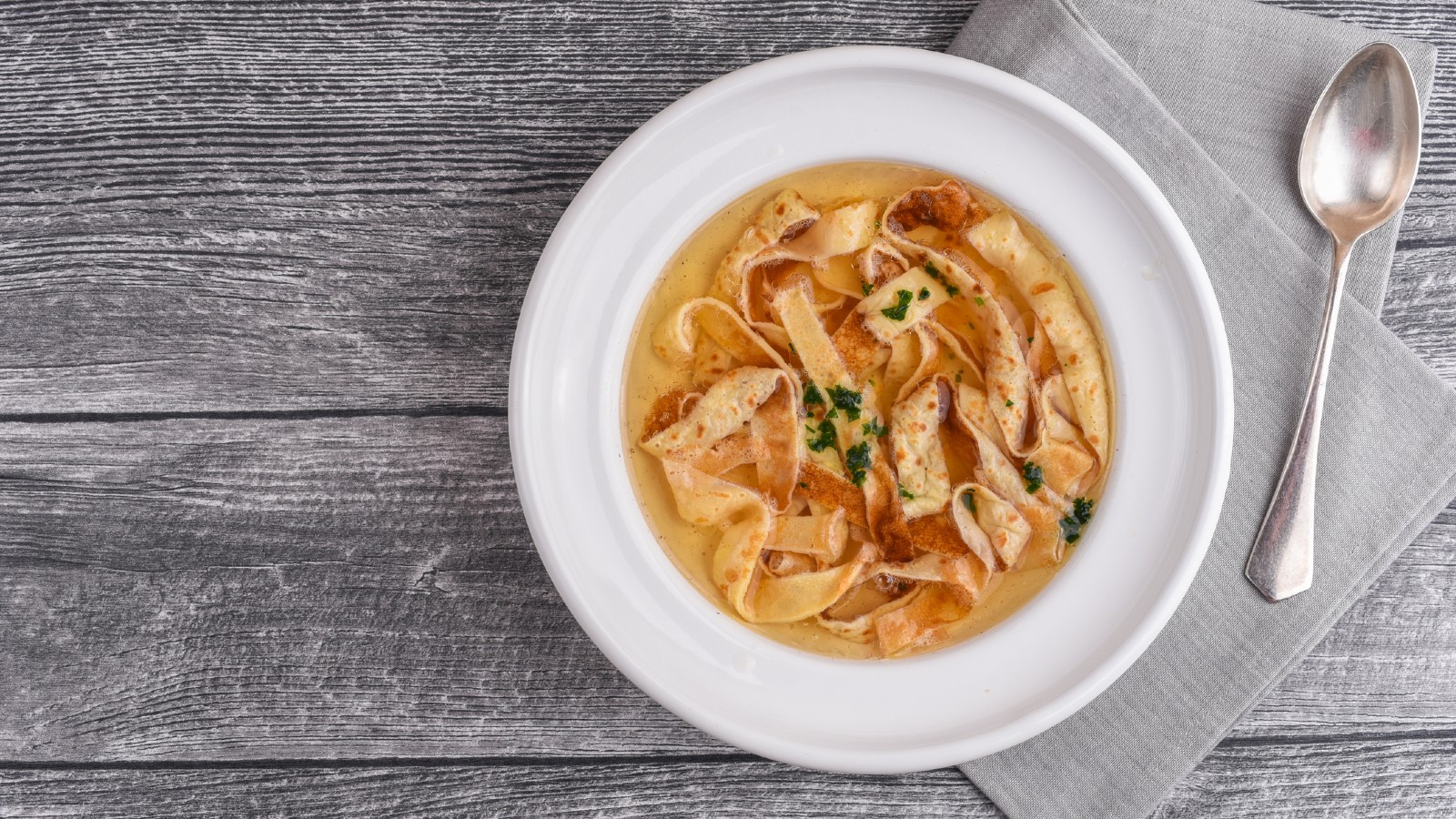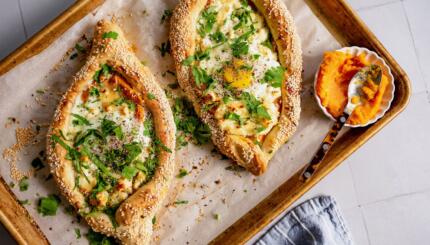Last April, as the pandemic raged in my area, I opened my front door to my dear friend Natalie, who literally threw at me from a distance a plastic sandwich bag containing her family’s cherished Passover tradition: flädla.
Less commonly known than the universally beloved matzah ball, these Passover egg noodles are made from a thin crepe that’s coiled and cut into strips, over which steaming broth is poured. Natalie’s family recipe was handed down from her mother’s tante Ilse, who emigrated from Germany in 1939 post-Kristallnacht.
Ask around about flädla and, like the history of any good noodle, you’ll discover the topic covers a lot of ground. Flädla, also spelled flädle, didn’t start off as a Passover food, but evolved into a dish that reflects the ingenuity and frugality of Jewish Eastern European cooks, who repurposed leftover dough or pancakes into noodles.
Noodles were a significant part of the Ashkenazi diet. In medieval times, Europeans began boiling dough in water rather than baking or frying it. In the Encyclopedia of Jewish Food, Gil Marks writes that noodles were predominantly used in soup and that some cooks cut up matzah meal blintzes into the liquid. No name was ascribed to that noodle or dish.
The Nosher celebrates the traditions and recipes that have brought Jews together for centuries. Donate today to keep The Nosher's stories and recipes accessible to all.
Recipes for Passover noodles are included in numerous Jewish cookbooks, notably June Feiss Hersh’s compilation of recipes from Holocaust survivors titled, Recipes Remembered: A Celebration of Survival, illustrating how deeply ingrained the dish was in people’s memories. Sometimes called lokshen, the Yiddish word for noodle, the recipes use matzah meal or potato starch, and always the same method of frying a thin crepe and cutting it into strips.
Pinpointing when, where, or who first adapted these noodle ribbons for the holiday is a challenge. “What is most fascinating to me,” says Gaby Rossmer, coauthor with her daughter, Sonya Gropman, of The German-Jewish Cookbook, “is how these food traditions travel. They do follow routes. You can see it, but you can’t tell exactly which one came first, which came second.”
Many Jews, like Natalie’s ancestors and Rossmer, lived in southern Germany; in the Swabian region, pancakes are known as flädle. The recipe has been handed down over generations; tradition dictates the crepes be thin and crispy. Flädlesuppe was a popular dish, but “never for Passover,” says Rossmer. She was a year old when she came to America from Bavaria, but fondly remembers frequently frying flour crepes with her father; the goal was always to have enough left over to make flädlesuppe.
The noodles are a key component of a comparable, popular Austrian soup called frittatensuppe, or pancake soup, which is always made with beef broth, says Nino Shaye Weiss, a blogger at JewishVienneseFood.com and Jewish food guide in Vienna. There, the crepes are called palatschinken; cut up they’re referred to as frittaten. “Jews do seemingly love them as they cannot live the eight days of Passover without them,” he comments, adding that frittaten for Passover are simply known as Peisachdike lokshen (kosher for Passover noodles).
Legend has it that frittatensuppe may have originated in 19th century Austria to feed Austrian, French, and Italian diplomats secretly meeting during the Congress of Vienna. One participant was Conte Romano de Frittata, whose coachman prepared the pancake. Frittata comes from the Italian word friggere, to fry; perhaps suggesting that the dish was named after the coachman’s employer. However, the only similar Italian-Jewish recipe I could find was for Minestra di Sfoglietti Per Pesach, a soup containing noodles of baked dough, in The Classic Cuisine of the Italian Jews by Edda Servi Machlin. If the story is true, the dish did not make its way back to Italy.
Holocaust survivor Cecile Gruer, 86, is known as her family’s chef. She movingly recalls eating flädla in 1946 at the first Passover she celebrated with her family in an Austrian displaced persons camp after they were reunited. Then a teen, she watched her mother prepare the noodle as her mother had done in Hungary. Greuer makes flädla year-round, using potato starch, matzah meal, or quinoa or almond flour for gluten-free relatives. Sometimes she’ll just mix egg and water, essentially an omelette. Gruer suggests adding any herb, such as dill or cilantro, to heighten the soup’s flavor. She continues these traditions because, she says, “You do not want to break the chain.”
Gruer’s and Natalie’s families enjoy their flädla in chicken broth with matzah balls. The Lubavitch sect, who follow the custom of gebrokts and don’t eat any dish where matzah can touch liquid, have just the noodle in their soup, says Leah Koenig, author of The Jewish Cookbook. Gruer confides she doesn’t like chicken soup. How does she eat her flädla? She laughs. “I would have it on the plate!”
Ingredients
- 4 eggs, separated
- ¾ tsp salt
- ¼-½ cup (to taste) chopped chives
- 4 Tbsp potato starch
- ¼ cup of chicken broth
- oil
Directions
- Separate the eggs and add the salt to the yolks.
- Mix chives and potato starch in with the egg yolks. Add as much chicken broth as is necessary for the mixture to be the consistency of pancake batter.
- Beat egg whites until stiff and add to yolk mixture (mix occasionally while cooking batches to avoid separation).
- Heat a small amount of oil in a frying pan and add enough batter to cover the bottom of the pan. Fry like a crepe, and remove from pan. Lay fladla on paper towels to absorb any excess oil.
- Let cool, then roll each crepe and cut into thin strips. Fladla can be made a few days in advance and refrigerated.
- Serve in hot soup and enjoy.



